Nov 27 2008
Full Circle: Memories of the Beginning
Today is the Thanksgiving Holiday in the United States. It is typically a holiday where families get together… the travel days around this holiday are often the busiest days from the entire year in airports and other travel hubs. As I am typing this my family is either in the kitchen preparing the afternoon meal (mmm, turkey) or outside running around (kids). I found myself – as I often do – migrating into my home office to check in online. While browing a few posts on BOB something occurred to me. I have come full circle in my “Adventures in Business Objects”.
I started working with the Business Objects products with version 3.1 in January of 1995. That’s a few years ago. 🙂 Being the packrat that I am, I still have the training material that Integra published for that version, and I thought it would be interesting to share some of the screen shots just to show how far things have come.
First, here is the icon that was used for Business Objects at that time:
![]()
The red dot was supposed to be the north star and the white curve was the horizon. The explanation was that the original product was called “Skipper SQL” so they went with a nautical theme. I have no idea if that’s true or not, but it made for a good explanation during training classes.
Things were a lot simpler back then. We had a query tool and the universe designer. Yes, even then we had universes to work with, but there was no “Supervisor” or equivalent. If you wanted to set up new users, you signed in to the query tool with a specific user name and password and you got extra menu options that let you set up security (such that it was back then). Here’s the basic login screen.

And of course we had a query panel. It looks a bit similar to what we have today, except that we don’t have a “sorts” area anymore.
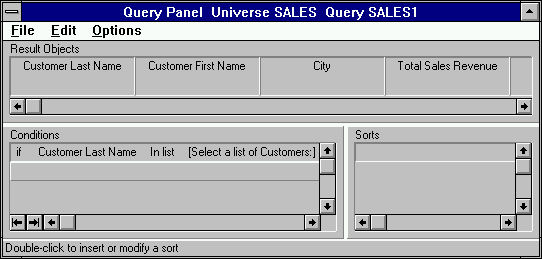
The data management part was completely different. Today we get information back in a standard report format and the raw data is hidden behind the scenes in a cube. With 3.1 we got the data displayed in ASCII format in rows and columns.
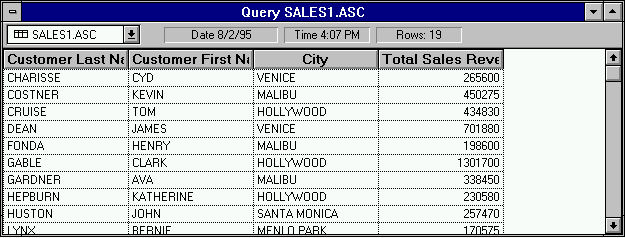
Instead of “tabs” we had a drop-down selector to move from one layout to another. If you look carefully at the data screenshot you’ll see the name “SALES1.ASC” which tells me I am looking at the raw ASCII data. The shot below shows a report, named “SALES3.E03” instead.
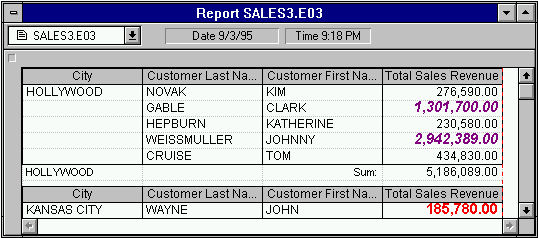
Here’s the selector. The ASC was the data, E01, E02, E03 and so on were reports. Why “E” instead of “R” for report? I explained it by saying that you “write” a report, and the French word for the verb “to write” is ecrivez which starts, as you can see, with the letter “E”. It would be interesting to know the true reason. 😆 A graph tab used a G instead of an E.
Update: please see the comments for a corrected explanation of why we had “E” for a report. Thanks to those that contributed via the comment form.

The report shows breaks and totals and even Alerters. Yes, we had Alerters back in the day, and we liked ’em.
What about variables? Yes, we had them back then. Here’s a screen that shows the variable editor.
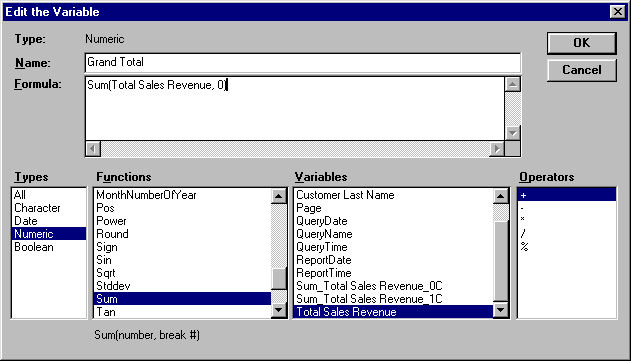
The syntax of “In Report” or “In Block” had not been created yet. Instead we used numbers to designate the proper context for a variable. In this case, the zero at the end of the formula designated that this was to be a grand total. It was very simple and easy to explain, which probably helps explain why the transition from 3.x to 4.0 was so traumatic for report writers. Variable context remains a sticky issue even today.
Charts? Yes, we had them. 🙂

Does this look a little bit like Crystal?
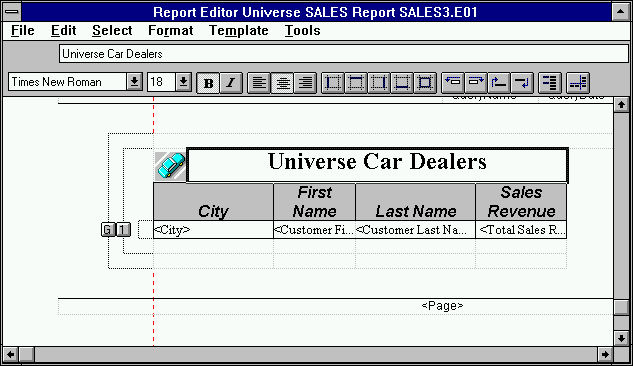
Did you ever wonder why the current PRM files include the classification IN_MACRO for functions? It’e probably because Business Objects 3.1 offered a feature called “Macro Objects” where were renamed to User Defined Objects in later versions. We even had a macro language that could be used to write “procedures” used in the reports (not to be confused with macro objects…)

Ah, memories. 🙂
So now I will return (full circle, so to speak) to the original topic of this post. I started with version 3.1. Today the current version of Business Objects is XI 3.1. I’m right back where I started fourteen years ago. 🙂 I am thankful that I have had the opportunity to be a part of this industry which has seen such dramatic growth and change over the past decade. What will the next ten or more years bring us? It’s exciting to think about, isn’t it?
Happy Thanksgiving everybody. Be thankful for your past and excited about your future. I know I am. 😎

Lovely post Dave, thanks for the screenshots! Also nice to see that not everyone feels the need to reinvent the wheel every 5 years and that some things just work well.
Wow, it looks awful! I didn’t start until 4.0, which even now doesn’t seem that different from what we have today 🙂
Wow. I came onto BO in Version 6 and thought that seemed forever ago. 🙂
How do we update our resumes to reflect the full circle of 3.1? That was the version I first began working with too!
Hi Dave. The word you are looking for is un etat, which is “the report” in french. You were close! (My hubby worked on that version at BO, so it comes from the froggie’s mouth.)
nod, thank you so much for that comment! It’s nice to know that I was at least close in my description for all of those years… 😀
I’m too use BO since 1995. At that time, BO had a Macintosh version of the product that was available before the PC version. I think I still have the old diskettes.
It brings many memories back. Thanks…
Explanation of the E in the extension. In french, a synonym of Report is “etat”. That’s why BO used the letter E.
Denis, not only did they have a Mac version they also had a Unix version as well. 🙂
Ya, my hubby was on the QA team for the Unix version. (I don’t know if that’s a good or a bad thing??!)
Thank you, Dave for your insightful post!
Back in 1997 When I started using 4x I was spared from the context paradigm shifts but have since had to really take advantage of report contexts to do some very tricky creations. Try creating a dynamic goal line in a 4.1 trend chart when the data does not exist in the DB… (I was able to do it with the early date functions 🙂 )
Hi Dave,
Thank you for this piece of memory. I try to contact you by email but I can’t find it here. Could you send me an email ? Thank you in advance !
(Bernard from BOB!)